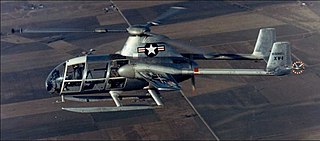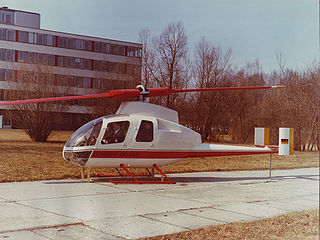Related Research Articles

The Fairey Rotodyne was a 1950s British compound gyroplane designed and built by Fairey Aviation and intended for commercial and military uses. A development of the earlier Gyrodyne, which had established a world helicopter speed record, the Rotodyne featured a tip-jet-powered rotor that burned a mixture of fuel and compressed air bled from two wing-mounted Napier Eland turboprops. The rotor was driven for vertical takeoffs, landings and hovering, as well as low-speed translational flight and autorotated during cruise flight with all engine power applied to two propellers.

The Hiller YH-32 Hornet was an American ultralight helicopter built by Hiller Aircraft in the early 1950s. It was a small and unique design because it was powered by two Hiller 8RJ2B ramjet engines mounted on the rotor blade tips which weigh 13lbs each and deliver an equivalent of 45 h.p. for a total of 90 h.p. Versions of the HJ-1 Hornet were built for the United States Army and the United States Navy in the early 1950s.

The Hughes XH-17 "Flying Crane" was the first helicopter project for the helicopter division of Hughes Aircraft Company. The XH-17, which had a two-bladed main rotor system with a diameter of 134 feet, still holds the world record for flying with the largest rotor system. It was capable of flying at a gross weight of more than 50,000 pounds (23,000 kg), but proved too inefficient and cumbersome to be mass-produced beyond the prototype unit.

The Fairey Jet Gyrodyne was a British experimental compound autogyro built by the Fairey Aviation Company that incorporated helicopter, gyrodyne and autogyro characteristics. The Jet Gyrodyne was the subject of a Ministry of Supply (MoS) research contract to gather data for the follow-up design, the Rotodyne.

The Fairey FB-1 Gyrodyne was an experimental British rotorcraft that used single lifting rotor and a tractor propeller mounted on the tip of the starboard stub wing to provide both propulsion and anti-torque reaction.

The Hughes XV-9 was a 1960s American high-speed research helicopter built by Hughes Helicopters.

The NHI H-3 Kolibrie was a small helicopter developed in the Netherlands in the 1950s by Nederlandse Helikopter Industrie.

The McDonnell XV-1 is an experimental gyrodyne developed by McDonnell Aircraft for a joint research program between the United States Air Force and the United States Army to explore technologies to develop an aircraft that could take off and land like a helicopter but fly at faster airspeeds, similar to a conventional airplane. The XV-1 would reach a speed of 200 mph, faster than any previous rotorcraft, but the program was terminated due to the tip-jet noise and complexity of the technology which gave only a modest gain in performance.

The Cicaré CK.1 was a light helicopter developed in Argentina in the 1970s. It was a small, single-rotor aircraft of pod-and-boom configuration with a fully enclosed bubble canopy that could seat three people side-by-side. Cicaré's previous helicopter designs had attracted the attention of the Argentine Air Force, which in 1974 contracted him to develop a light helicopter for training and also marketed for agricultural use. A prototype, registered LV-X62 flew in September 1976, and the Air Force placed an order for five pre-production machines. However, development was terminated at this point.
The Fiat Model 7002 was a 1960s Italian general-purpose helicopter with a tip-jet driven rotor built by Fiat Aviazione. Only one aircraft was built.

The Sud-Ouest S.O.1221 Djinn is a French two-seat light helicopter designed and manufactured by aircraft manufacturer Sud-Ouest, which later became Sud Aviation. It was the first indigenously-developed French helicopter, as well as being one of the first practical European helicopters to be produced. The Djinn was also the first rotorcraft to harness tip-jet propulsion to enter production.

The Dornier Do 132 was a utility helicopter under development in Germany in the late 1960s. While the design was a conventional pod-and-boom layout, the propulsion system was unusual in that it used a turbine engine, not to drive the rotor directly, but to provide a source of hot gas that was fed through the rotor shaft, along the blades, and out through tip jets. The intention was to eliminate the weight and mechanical complexity of a gearbox and an anti-torque system for the tail.

The Fairey Ultra-light Helicopter was a small British military helicopter intended to be used for reconnaissance and casualty evacuation, designed by the Fairey Aviation Company.

The Dornier Do 32E was a simple, collapsible one-man helicopter, designed for military use in Germany in the 1960s. Despite initial hopes of large orders and some proposed civilian roles, only three flew.
The Avian 2/180 Gyroplane was a two-seat, single-engine autogyro built in Canada in the 1960s. Several prototypes were built but production was not achieved.
The Fiat 4700 was an Italian turbo-generator developed by Fiat Aviazione under contract to the Italian Defence Ministry and used to power the experimental Fiat 7002 tip jet helicopter.
The American Air Jet American is an American homebuilt tip jet helicopter designed and built by American Air Jet of Woodland Park, Colorado for amateur construction from kits.

The Sud-Ouest Ariel is a French two-seat light helicopter designed and built by Sud-Ouest. The helicopter rotors were driven by compressed-air jets at the end of each blade.
The Kaman K-17 was a two-seat experimental helicopter built by Kaman in the late 1950s. It used a cold-jet rotor system.
The McDonnell 120 Flying Crane, also V-1 Jeep, was a lightweight utility flying crane helicopter designed and built by the McDonnell Aircraft Corporation during the 1950s. The open frame fuselage supported the three gas-producers and main rotor mast, with a small single-seat cockpit in the nose, which was originally open, but later enclosed.
References
- Taylor, Michael J. H. (1989). Jane's Encyclopedia of Aviation. London: Studio Editions. p. 348.
- Jane's All the World's Aircraft 1979-80. London: Jane's Yearbooks. pp. 520–51.